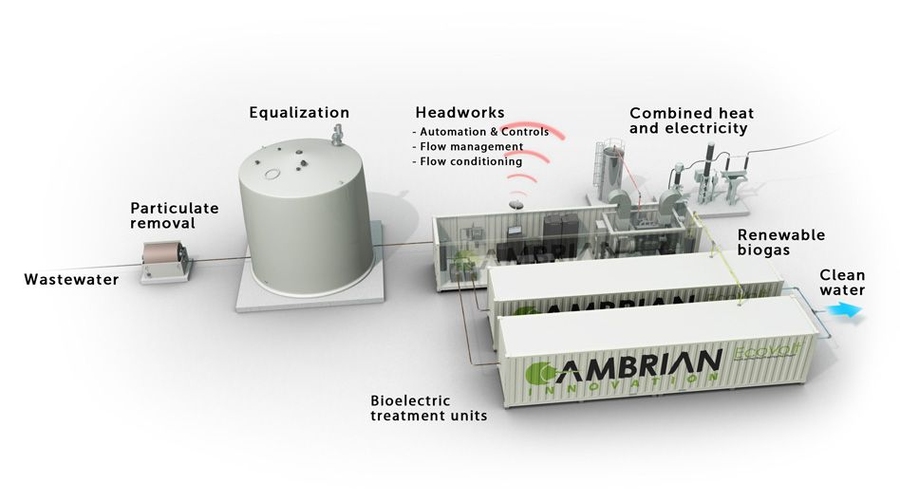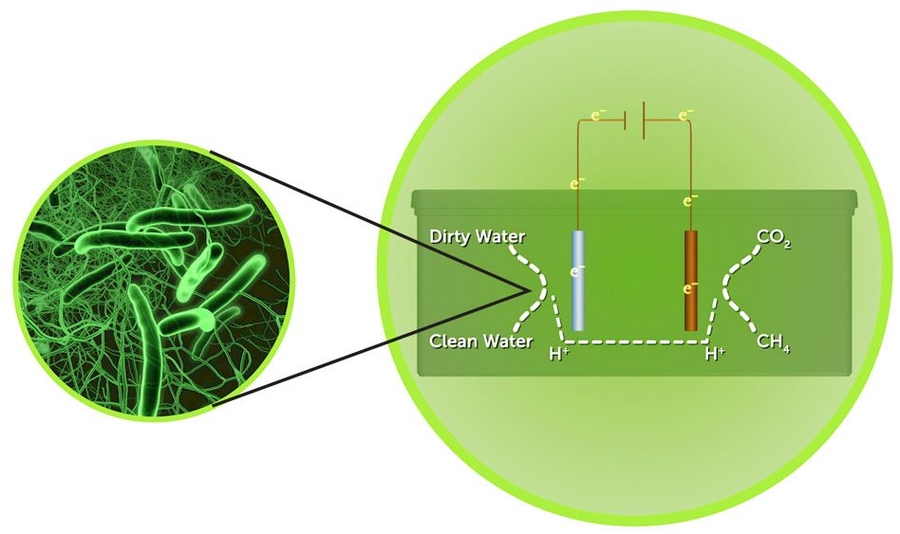Each day, breweries and wineries produce thousands of gallons of wastewater, which is either poured down the drain or shipped to treatment facilities at a high cost to the companies.
Now MIT spinout Cambrian Innovation is commercializing a novel treatment system, called “EcoVolt,” that uses electrically charged microbes to treat and create power from wastewater. The company — which aims to leverage biotechnology as a way to solve environmental issues — is also modifying their system to generate value from wastewater in agricultural and military fields, and to convert carbon dioxide to fuels for applications on Earth and in space.
Today’s industrial infrastructure manages basic resources linearly, raising the cost of waste disposal and causing environmental harm. But a more cyclical approach — where waste is used as an energy source — could provide higher profit yields and “eliminate the tension between the environment and economics,” says CEO Matt Silver SM ’05, PhD ’10, who co-founded Cambrian with Justin Buck PhD ’12, now the company’s chief technology officer.
“The treatment of wastewater, for example, consumes over 3 percent of the electricity in the United States, yet organics in the wastewater have energy that can be extracted and used locally,” Silver says. “And that’s the case for a lot of waste products in general.”
Cambrian’s automated and modular EcoVolt system — delivered on a flatbed and installed over a few weeks — consists of a headworks unit, which houses computers for automation and control, and expandable 20,000-gallon treatment units. In these units, microbes called “exoelectrogens” execute a unique process, electromethanogenesis — which is being used for the first time ever in treating wastewater.
Exoelectrogens, coated on anodes, consume the wastewater’s remaining organic pollutants and, in the process, generate electricity. This electricity travels through a circuit and onto cathodes coated with separate microbes that consume that electricity — along with carbon dioxide — to produce biogas at a rate of up to 100 cubic feet per minute. This process enhances naturally occurring anaerobic digestion in wastewater, Silver says, as it stabilizes treatment, improves biogas quality, and enables a higher degree of automation.
The biogas enters a connected cogeneration system for power conversion. Depending on several site factors, this produces anywhere from 30 to 400 kilowatts of electricity. Treated wastewater exits the reactor with 80 to 90 percent of pollutants removed, so it can be used for irrigation, equipment washing, and other things.
The system can treat 10,000 to 1 million gallons of wastewater daily. At that rate, a winery would shave about 2 pounds of CO2 per case off of its carbon footprint, through carbon-free energy generation and avoiding municipal wastewater treatment — “effectively planting over 4,400 acres of trees in a year,” Silver says.
Since January, the Bear Republic and Lagunitas breweries, both in drought-stricken California, have purchased EcoVolt systems. At current usage rates, Cambrian estimates the system will generate enough electricity to meet 25 to 50 percent of these breweries’ needs and allow reuse of about 25 percent of their water. It could also eliminate 10 trucks of wastewater shipping per day for Lagunitas.
All in the design
Increasingly, the beverage industry has employed anaerobic and aerobic wastewater treatment processes, but these are expensive and difficult to adopt, Silver says.
Aerobic processes — dissolving air into wastewater, where aerobic microorganisms degrade pollutants — consume a lot of energy and generate biosolids (organic materials) that are managed at cost. Processes where anaerobic microbes eat pollutants, while producing small amounts of burnable methane, have gained popularity in the last few decades — but such systems only function under specific circumstances, are prone to failure, and are difficult to operate.
EcoVolt, on the other hand, is applicable to a range of sites, and has demonstrated a more robust treatment process, meaning better power generation and higher yields for customers — and is therefore more economical, Buck says. But the system is also modular, meaning customers can incrementally add components, such as larger treatment units or conversion generators.
It’s an architecture influenced by Silver’s graduate years in MIT’s Engineering Systems Division, which stresses reliability, scalability, and flexibility in designing large-scale, complex systems. “EcoVolt gives them more flexibility with how they implement treatment systems,” he says. “The whole idea is to minimize nonrecurring engineering and operating costs, while providing customers with the option to expand at low cost via a modular architecture.”
Moreover, though, EcoVolt is automated, remotely monitored, and provides real-time data — thanks to using exoelectrogens as sensors. “These bugs are generating electricity, and that’s something we can sense and read out, in real-time, to see how well the reactor is doing,” explains Buck, who invented Cambrian’s sensor technologies.
With EcoVolt, Silver says, Cambrian aims to make treating and reusing water easier and more affordable, as America’s dependence on water increases, along with water pollution.
“Almost every product we make has a water footprint,” Silver says. “As our economy grows, water tables are dropping and wastewater pollution is rising, causing many companies to consider water risk in their overall strategy. The need for more cost-effective solutions is increasingly acute in the developed world, and also critical in the developing [world]. We are leveraging biotechnology to provide the highest return on investment for managing water.”
To that end, Cambrian is working on other projects that leverage exoelectrogenic microbes to treat wastewater. One project, called BioVolt, is a self-powered water treatment system for U.S. Army forward operating bases that treats wastewater and generates electricity to power itself. Another project, funded by the National Science Foundation, uses exoelectrogens to sense nitrate in wastewater, cheaply and with very high specificity, for the agricultural industry.
“Earth as a spaceship”
EcoVolt is valuable today as a solution to Earth’s water issues. But the core technology began as a bit of aerospace ingenuity — and has since found its way back to space.
Meeting at MIT in 2006 over a shared fondness for biotech, Silver, then a research scientist in MIT’s Space Systems Lab, and Buck, a biological engineering graduate student, won a grant from the NASA Institute for Advanced Concepts program to create a life-support system that could treat waste and generate electricity for astronauts. Soon, they came across exoelectrogens; a 1999 study had revealed that exoelectrogens could, in fact, generate more amps per square centimeter than was previously thought.
This made exoelectrogens a third — and largely better — candidate for wastewater treatment, over aerobic or anaerobic methods. Launching Cambrian with a Department of Agriculture grant to focus on agricultural wastewater, the team soon moved to its current Boston headquarters. By the time they entered the 2010 Cleantech Open competition — and won — they had shifted focus to the food and beverage industry.
Cambrian successfully piloted its first system in 2010 and then, over 14 months, from 2011 to 2012, demonstrated its system at industrial scale at the Clos du Bois winery in California.
In 2012, NASA began funding a Cambrian project, called ExoGen, that uses electromethanogenesis to more efficiently extract oxygen or fuel from CO2 for long-duration space flights. NASA currently carries out oxygen recovery from CO2 in a multistep chemical process; ExoGen will make it a simplified, one-step process.
Surprisingly, shifting from aerospace to Earth applications, and back again, has been an easy transition, Silver says. “The challenge of supporting astronauts in space is very similar to sustainability on Earth,” he says. “What you’re looking to do in space is maximize reuse, while minimizing energetics. If we look at Earth as the spaceship, it’s the same problem.”
With EcoVolt, and its other ongoing projects, Cambrian’s overall aim, Silver says, is to leverage biotechnology to advance a sustainable “industrial ecology,” where the waste of industry is recycled to create energy and value — much like in natural ecosystems.
“In a natural ecosystem, there really is no such thing as waste,” Silver says. “It’s just another resource.”







